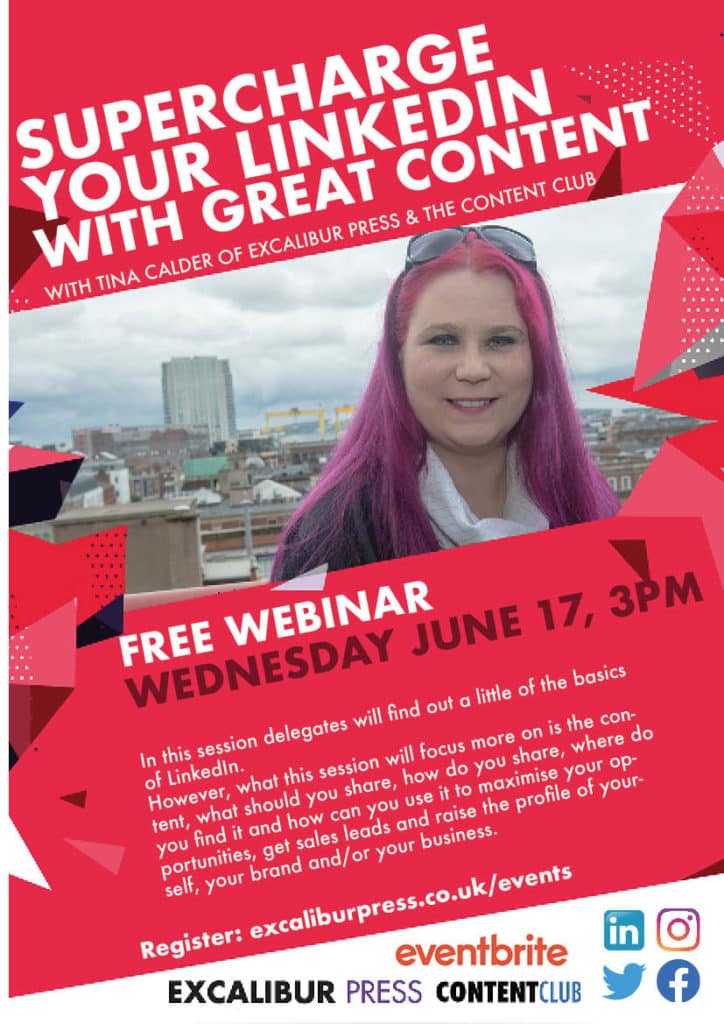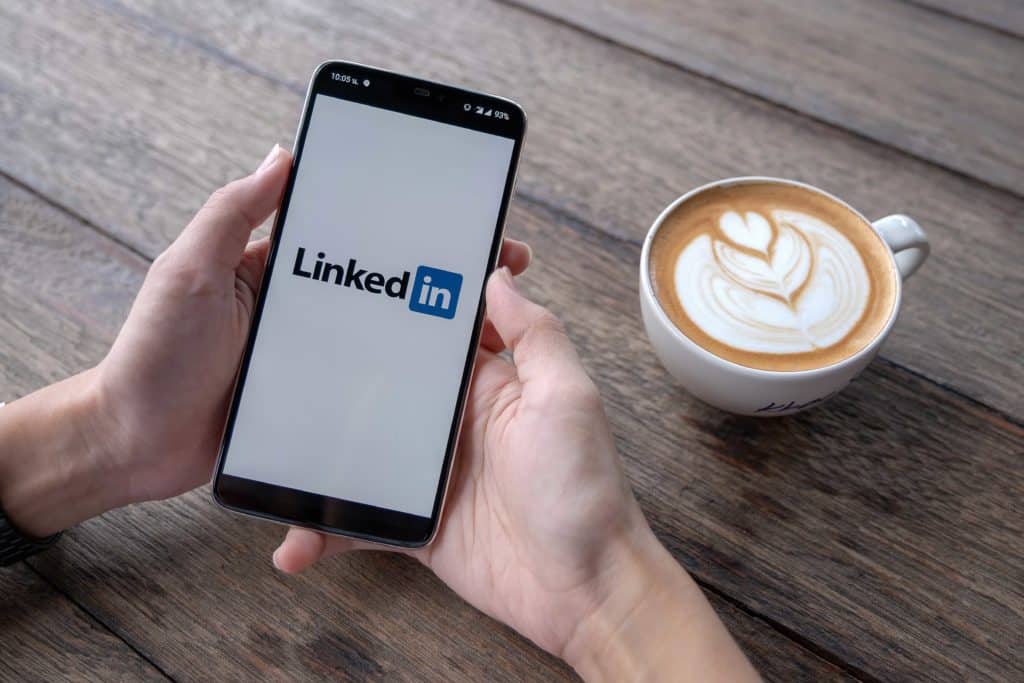Across the country businesses are being given the green light to re-open following a lengthy period of closure.
Whilst there may be a range of practical considerations they need to be thinking about it’s vital business owners aren’t forgetting the importance of creating engaging and relevant content on social media.
That’s the message from content specialist and publicist Tina Calder of Excalibur Press who will be presenting her free webinar Supercharge Your LinkedIn With Great Content tomorrow (Wednesday June 17) at 3pm.
She said: “For many businesses, especially those who are targeting business people or are working in a b2b setting, they should not underestimate the power of showing your customers that you’re back, you’re stronger than ever and able to give them content that they can and will engage with.
“When a crisis happens in a business more often than not things such as social media, digital marketing and communications tend to be pushed to the side in favour of what is considered an immediate need.
“The problem with that is by the time you do put focus into these things it’s often too late.
“Creating strong, engaging, organic content now can help to support your brand to return to the market and back up your marketing and sales strategy for your comeback.”
Tina’s 90-minute webinar Supercharge Your LinkedIn With Great Content will help attendees unlock some of the secrets of the popular b2b social platform and is packed full of top tips, tricks, tools and techniques to help you go it alone and do it yourself.
Tina added: “This webinar will go over some of the basics of optimising your profile, however, what we will focus on more is the content, what should you share, how do you share, where do you find it and how can you use it to maximise your opportunities, get sales leads and raise the profile of yourself, your brand and/or your business.”
Supercharge Your LinkedIn With Great Content is part of a series of free webinars each week by Tina and Excalibur Press helping businesses look at a variety of elements of their digital transformation during the Covid-19 crisis.
One element of this webinar is Tina’s 79 types of content you can share on the platform.
To give you a taste of these, here are just 9:
1. How to
‘How to’ content offers your audience massive value and often performs well because you’re helping the audience to solve a problem that they (might) have.
At the same time, publishing this type of content benefits you because you’re giving them an example of your expertise in your field. You can create a how-to video or set out the instructions step by step in text.
Either way, they’ll thank you for it by consuming more of your content in the future.
2. Case studies
Case studies are a big opportunity to demonstrate the value of your product or service, often by telling a real-life story of how your business has helped a customer or client of yours with a business problem.
In essence, case studies are a sales tool. The person reading the case study should be able to picture themselves using your product or service by the end they finish reading it.
The more interesting the angle or more challenging the client’s problem, the better for your case study and you’ll relate how your business was able to solve the problem for them. You should be portraying yourself as a supportive element and, ideally, you should back up the key points of your case study with data to convey the value of your product or service.
3. Behind the scenes
Maybe you’ve heard it a million times before now, but it’s really true: people buy from other people. They like to know who they’re buying from and the behind-the-scenes content gives you a chance to really connect with your audience and humanise your brand.
Behind-the-scenes content is transparent, not excessively polished and, like a case study, is about the process. Your audience gets to see what’s going on behind the brand and the content helps them to understand your business better. It builds trust in your business and your expertise starts to shine through naturally.
4. Opinion
An opinion piece gets people talking and can even become news in itself, but be careful not to become notorious. If your opinion pieces leave a nasty taste in your audience’s mouths regularly, they could harm your brand reputation.
Ideally, the pieces should be balanced and base themselves on an objective analysis of the facts and evidence, not necessarily be providing the evidence itself. Note that just because a piece should be balanced, that doesn’t mean it can’t be hard-hitting if it’s appropriate to be so.
The purpose of an opinion piece is to help the reader form their own opinion and should enlighten them or empower them. All throughout, the piece should be entertaining enough for them to read right until the end and make them want to read more pieces by you. Be careful not to impose your own views heavily on them. You’ll lose your audience otherwise.
5. Interviews
Unique content is crucial in content marketing and interviews are a terrific way to create this. They’re also an easy way to generate content. The person you’re interviewing will create lots of valuable material you can use for your content. You can then create a text article, video or podcast of the interview. Experiment with different media to find the one that suits you.
Interviews give you the chance to reach out to influencers in the industry, who can offer some excellent insight.
Don’t worry about being on a ‘lower’ level than they are: the interview will give the influencer free publicity, so many will be happy to do it and if people see you interviewing several major influencers, they’ll start to perceive you as having slightly higher authority. They start to associate your business with the major influencers and you’ll become an influencer in your own right.
6. Throwbacks
Everyone loves a blast from the past, which makes ‘throwback’ content a powerful content marketing tool. It’s nostalgic and allows you to create an emotional connection with their audience. It’s also a lot of fun and you can really engage your audience.
One way you can create throwback content is to dig into your business’s archives and share a video, picture or social post from your early days in the business. It could be from when you were just starting out and still trying to figure everything out as a business owner. You can compare yourself to now and discuss how far the business has come since then.
7. “Meet the team” posts
Introducing your audience to your team is a part of your brand storytelling. It’s a powerful way to show your audience the people behind the brand, who are just as important as the company itself, and adds a personal touch to your content. Choose videos or text posts with an image, but either way, let people see your team.
Publishing “Meet the Team” content will also build trust with your audience. This is because you’re no longer “faceless”. When your audience sees names and faces, you become a “real” company to them all of a sudden. In an age where people are concerned about online scams, your “Meet the team” content will build your credibility.
8. FAQs
The chances are you’ll hear some of the same questions a lot in your industry, which gifts you with a great opportunity to create truly valuable content for your audience in the form of FAQs. Make a note of the questions you hear most often — or even just all of the questions you hear — and create a separate LinkedIn post for each one and answer the question.
You can teach your audience and help them to learn about your industry. You can teach them about your products and services and how to use them successfully. You can discuss how you’ve helped other businesses. Answering people’s questions with your content will build trust and increase your credibility with your audience.
9. Long form articles
Did you think that people want really short content on LinkedIn?
You’ll be surprised. The Content Marketing Institute has reported posts with 1 000 to 3 000 words get more shares, even though shorter content dominates LinkedIn. Posts can be text heavy and have simple elements such as bullet-pointed lists. You don’t have to pack them with images and charts etc.
The CMI suggested three main reasons for the higher numbers of shares that longer posts enjoy:
LinkedIn is a refuge from the pressure to add images and videos to prose.
People base their sharing activity on how important they perceive the author of the content to be. An impressive job title can capture as much attention as visual elements.
The structure as a network for professionals, which creates minimum expectations for entertaining content.
LinkedIn has evolved immensely in the last few years and is an essential tool for marketing your business. The platform offers lots of scope to create amazing content and, just like on other platforms, audiences will reward good content. They’re receptive to lots of different types, which means there are plenty of opportunities to produce excellent content and really build a positive brand image.
Register for Supercharge Your LinkedIn With Great Content at https://bit.ly/3huRS7z
Tomorrow (Thursday June 18) Tina will also be delivering her popular Blogging For Business webinar at 3pm.
For details of forthcoming free webinars go to https://excaliburpress.co.uk/


